UMD, UND charge into Frozen Four
By John Gilbert
With apologies to Hockey East and the ECAC, the 2011 NCAA Frozen Four has come down to a good-ol’ fashioned Western showdown, with the WCHA squaring off against the CCHA in what might be called the Xcel Xtravaganza. North Dakota and Minnesota-Duluth from the WCHA are paired against Michigan and Notre Dame, CCHA opponents that began their hockey programs as members of the WCHA, in the semifinals on Thursday, April 7 at Xcel Energy Center in Saint Paul.
North Dakota is top-seeded, although that has been no guarantee so far in the tournament. The Fighting Sioux, in fact, came through as the only regional top seed to make it to the Frozen Four in what has been the Year of the Upset so far. Michigan was second-seeded in the West Regional and barely survived against two other WCHA teams. UMD and Notre Dame were both third seeds, with UMD knocking out the top two ECAC teams to win the East Regional, while Notre Dame got past a pair of Hockey East foes to win the Northeast Region.
Ticket prices of $195 apiece haven’t stopped the demand, particularly from UMD, the only one of five Minnesota Division I programs to be playing in the homestate championships, and North Dakota, which has made it a tradition to travel by green-clad carloads to the Final Five at Xcel Center, which they won two weeks ago.
North Dakota is the clearcut favorite, coming in with titles in the WCHA regular season, the WCHA playoffs, and the Midwest Regional already headed for the trophy case. Clearly, the Fighting Sioux are at the peak of an exceptional season. But if this is the Year of the Upset, UMD is in good company, joining Notre Dame and Michigan as teams that won regionals where the top seeds were beaten.
The form chart held at the Midwest Regional at Green Bay, Wis., where North Dakota crushed RPI 6-0, and No. 2 seed Denver came from a 2-0 deficit to force a tie and then beat Western Michigan 3-2 in overtime. The anticipated rematch of the Final Five title game, which North Dakota won in overtime, saw the Fighting Sioux blitz Denver with a surprising 6-1 rout. Denver played well, but North Dakota was relentless, scoring at full strength, on the power play, shorthanded, empty netter — every imaginable way to push the score beyond the game’s level of competitiveness.
Elsewhere, the form chart meant nothing. UMD, as the third seed, surprised second-seeded Union 2-0 in the East Regional at Bridgeport, Conn., then the Bulldogs surprised the hockey world by stunning No. 1-overall seed Yale, racing to leads of 3-0 and 5-1 to beat those other Bulldogs 5-3. UMD goaltender Kenny Reiter was named most valuable player of the regional, after his acrobatic play stymied both ECAC foes.
UMD opens the Frozen Four in the 4 p.m. semifinal against Notre Dame, which upset Merrimack in the Northeast Regional at Manchester, N.H., while fourth-seeded New Hampshire upset top seeded Miami of Ohio. Notre Dame then beat UNH, no small achievement in Manchester, to reach the Frozen Four.
In the West Regional, defending NCAA champion Boston College was the overwhelming favorite, but was shocked and flat overrun by Colorado College in the first game at St. Louis, while Michigan got past Nebraska-Omaha in overtime on a controversial reversal by the officials, who changed their call of no-goal to a goal for the Wolverines, bringing new meaning to the term “sudden death.” The puck had bounced off a UNO defenseman and wound up under the leg pad of goaltender John Faulkner, whose leg wouind up on the goal line. Video replays showed Faulkner’s leg pad, but the goal line and the puck were both completely concealed, until the puck squirted out, and out of danger. Repeated views couldn’t change the fact that there was no evidence the puck had completely crossed the goal line, and certainly not enough evidence to change the original call. But after reviewing the videos for nearly 10 minutes, the officials declared that it was a goal, and Michigan won. The Wolverines also held off Colorado College 2-1 through a wave of penalties to claim the regional.
“Going to St. Louis, it was a foregone conclusion that Boston College had the best team, but Colorado College just spanked ’em. We got a lucky to win in overtime against Nebraska-Omaha, then we got by CC,” said Michigan coach Red Berenson, who is in his 27th season, and has remained as candid and humble person he was as a star player with the Wolverines and later in the NHL. “We had to kill seven penalties against CC, which had as good a power play as we’ve seen. We were fortunate to get out of the game alive.
“Three other No. 1 teams have gone down, and this is the last one standing — North Dakota. I don’t know if we can match North Dakota’s speed, or skill, and nobody has found a way to take that out of the game. They’ve got the edge in offensive skills and in special teams. We’ve got to play our game, and give it our best shot. We have an above-average team, led by the seniors. When we had our best team, we had seven 20-goal scorers; this team has no 20-goal scorers. But we haven’t been in any lopsided games. We’re probably the overwhelming underdog in this tournament, but we still have a chance.”
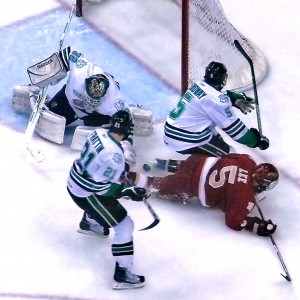
North Dakota's top-seeded Sioux are led by goalie Aaron Dell, top scorere Matt Frattin (21), defenseman Chay Genoway.
Under Hakstol, the Sioux have often started slowly, then built to a peak during the second half. This season, they started strong and never let up. “What we did well is keep ourselves focused on the job at hand and play a good team game. When you break down a game on video, there are a lot of points in a game when momentum can shift one way or another, if you get distracted or let a bad bounce get to you. We did a good job of worrying about the next play and trying to control what we can control. There are little areas that we hope we can improve on. We’re not going to make any drastic changes to our game, just do all the little things we’ve done.”
A forceful and balanced scoring offense is led by Matt Frattin, who won the league scoring title with a nine-point final weekend at Michigan Tech. Aaron Dell came in and became the top goaltender, and led all WCHA goalies in statistics. Even a string of injuries, including absences by key standouts like defenseman Chay Genoway and forwards Danny Kristo and Jason Gregoire, didn’t slow them. Genoway came back a few weeks before the end, Kristo returned from a case of serious frostbite in time to score in both Final Five victories, and Gregoire rejoined the lineup for the regiona. Hakstol, and the team, never wavered.
“Injuries have been a challenge for us,” said Hakstol. “When we went to Wisconsin, [Andrew] MacWilliam and [Derek] Forbort, who were paired on defense, both were dieagnosed with mono. It’s been the same way whenever anyone was out of the lineup — whichever 20 guys are available, they have the expectation to individually contribute and collectively succeed. This past weekend, we had everyone.”
As for facing Michigan, Hakstol said: “Our team will continue with the same mentality we’ve had since the beginning. We’ve shown up and worked hard, but we’ve been loose and had fun doing that. We felt we played well at Green Bay, but we have to continue to improve our game. We will prepare ourselves as we always do, for each and every opponent. This time of year, you need to be prepared to win games in different ways, different fashions, and have to have the mentality to get the job done however you have to do it.”
Someone asked if he had a preference for which opponent the Sioux might face if they beat Michigan. “I have a preference,” said Hakstol, “that at the end of the game, we’ve won the game.”
UMD, which split with North Dakota in two games at Grand Forks and lost a ceremonial game against the Sioux at the opening of Duluth’s Amsoil Arena, was ranked No. 1 in the country at midseason. The Bulldogs never lost two games in a row, and were never swept by any opponent all season, and have been led by the quick and clever first line of Jack Connolly centering Mike Connolly and Justin Fontaine, and an agile and rangy defense. Goaltending was shared by Kenny Reiter and Aaron Crandall, until, ironically, coach Scott Sandelin decided to go with Reiter down the stretch. Over the final four games, UMD had a chance to win the title, or finish second, or third, but dropped to fourth in the extremely close WCHA.
Getting it back together to sweep St. Cloud State in the playoffs sent the Bulldogs to the Final Five, where they were promptly dumped by Bemidji State in overtime. That loss was only UMD’s second in 14 overtime games this season, a record of 6-2-6. But that hardly sent UMD off to the East Regional flushed with confidence — theirs or their fans. But it was there that everything snapped into focus: Reiter became invincible, the defense became a shot-blocking gang, and the Connolly-Connolly-Fontaine line led the attack. Those three and Frattin remain the top four WCHA scorers in all games this season.
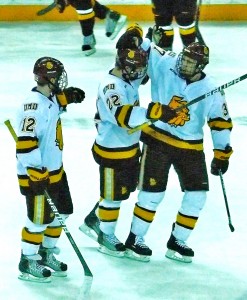
UMD's Jack Connolly (left), Mike Connolly (center), and Justin Fontaine are NCAA's top-scoring line.
Could the loss to Bemidji State have worked as an incentive? “It did sting,” said Sandelin. “I didn’t think we played very well, but give Bemidji a ton of credit. After that game, there was some disappointment. This group hasn’t lost a lot and they don’t like losing. It was interesting after we won the East Regional. Our guys were excited, but not overly excited. They captured the moment, and took it in stride. We advanced, but they were looking forward to not just getting to the Frozen Four, but having the chance to win a national championship.”
Notre Dame coach Jeff Jackson has built the Irish into a power, which is no surprise to those who remember him winning NCAA championships at Lake Superior State in 1992 and 1994. He took the Irish to the Frozen Four in Denver three years ago, but is quick to say he is pleasantly surprised by the coming together of this youthful group. “Were thrilled to death to be coming to St.Paul for the Frozen Four,” Jackson said. “It’s an unexpected treat for a young team.
“As a coach, this is one of more fun years I’ve had in a long time. We really paid a price, with 10 or 11 freshmen in the lineup every night, but last weekend, we responded both on Saturday and Sunday. All the signs show we’re growing up. Goaltender Mike Johnson played well. This group is one of closest teams I’ve ever coached, maybe the closest. It was interesting to watch them after we won the regional. They were all together, arm in arm, for our alma mater. That’s a first. The locker room was pretty entertaining, from my perspective. Because of the youth, there has been some consternation. I wasn’t sure what to expect going into the regional. We didn’t have a real long winning streak all year, but every time somebody is ready to count them out, they come back. I have to bite my lip and hold my breath sometimes, but they’re great kids, and our seniors have done a great job with them.”
Rising up to win the Northeastern Regional required the consistency that had been questionable. “Last weekend, the keys were that we paid more attention to detail, offensively and defensively,” Jackson added. “I thought we proved we could do things for the full 60 minutes, and not drift off. Both Merrimack and UNH scored late, but we played through it, I watched the growth of our team, and we have to carry that with us to the Frozen Four.
“I know Duluth plays a real high-tempo game. We try to do that too. We’ve shown the ability to play both ways, but in the CCHA, when you’re playing Michigan or Miami, you have to be able to play an up-tempo game.”
A year ago, Boston College won the national championship with a high-speed, up-tempo team. This year, all four teams in the Frozen Four prefer an up-tempo game. “That’s a good observation,” said Berenson. “Three of the four No. 1 seeds were upset, but maybe they weren’t upsets. Maybe we’re talking more parity. I like the direction college hockey is going. There’s a good tempo up and down, and the hockey is better hockey than what we’ve seen in previous years.”
Optima moves Kia to top of charts
By John Gilbert
The first time I saw a 2011 Kia Optima, it was difficult to look away. It was parked in subdued evening light, on a grassy area in a California hotel’s courtyard. I circled the car, from the front, around to the side, looking at every curve and every line, and then I walked to the rear corner.
I suggested to a fellow-automotive journalist that the car looks more as though it should have an Acura or Lexus badge on it, than a Kia logo. He said, “From the rear corner, it looks as though it was built by Jaguar.”
He was right. The slope of the roofline as it angles down to the rear fenders in the new-world concept of a 4-door coupe makes it strikingly similar to the new and spectacular Jaguar XF sedan. It has a smooth body with a classy appeal that looks like it should cost at least twice its price. The fact that a couple of occasionally cynical auto journalists were comparing first views of the car with Acuras, Lexuses and Jaguars speaks volumes. Kia calls it “breakthrough styling in a bland segment.” Read more
WCHA’s 1-2 in Green Bay, UMD goes East
By John Gilbert
Anyone who witnessed the emotionally charged battle between North Dakota and Denver in the WCHA Final Five tournament at Saint Paul’s Xcel Energy Center might think it would be great to have a rematch between the league’s No. 1 and 2 teams. With the NCAA Frozen Four set for Xcel, that might seem feasible.
Instead, if it’s going to happen, it will be in Green Bay, Wis., in the Midwest Regional. North Dakota (30-8-3) will face Rensselaer (20-12-5) and Denver (24-11-5) plays Western Michigan (19-12-10) on Saturday in Green Bay, with those winners colliding on Sunday to grab one of the four slots in the Frozen Four. After North Dakota claimed the WCHA league title with Denver runner-up, then North Dakota beat Denver 3-2 in two overtimes in the WCHA Final Five championship game, it seemed as though those two teams might be separated into different regions, with a chance to both reach Saint Paul again.
“First, all 16 teams that have gotten to this point are good,” said Denver coach George Gwozdecky. “We have a guy on our staff who follows the Pairwise very closely, and he laid out the way he thought the NCAA would pair the teams according to record, and he was right on. So it wasn’t really a surprise to us.”
North Dakota, which ranks No. 2 in the nation behind only Yale, has been bolstered recently by the return of captain and defenseman Chay Genoway, and winger Danny Kristo made his return at the Final Five, scoring the first goal in both the 4-3 semifinal victory over Colorado College and the 3-2 victory over Denver. Now the Sioux regain the services of Jason Gregoire.
Four of the five WCHA teams to make the tournament are bunched into two regionals, with the West Region in St. Louis seemingly the toughest, with defending NCAA champ Boston College (30-7-1) facing Colorado College (22-18-3), after Nebraska-Omaha (21-15-2) taking on Michigan (26-10-4) in a Friday-Saturday regional. WCHA boosters might anticipate a CC-UNO final, but that would require two upsets, based on the 1-2 seeding of BC and Michigan. Nationally, BC ranks No. 3 and Michigan N. 5, while Omaha is No. 12 and CC No. 14.
The national rankings show: 1. Yale, 2. North Dakota, 3. Boston College, 4. Miami, 5. Michigan, 6. Merrimack, 7. Denver, 8. Union, 9. UMD, 10. Western Michigan, 11. Notre Dame, 12. Nebraska-Omaha, 13. New Hampshire, 14. Colorado College, 15. RPI, 16. Air Force. The NCAA selection committee followed those strict Pairwise guidelines, No. 1 vs. 16, 2 vs. 15, and so forth, placing each of the top four teams as a top seed in each regional. That form also allowed each regional to have one team from the 5-8, one from 9-12, and one from 13-16. It fit together well enough that it superceded other less-strict criteria.
It also succeeded in avoiding having any of the five WCHA teams, four CCHA teams, or three teams from Hockey East and the ECAC from facing each other in the first game, but it was impossible to avoid those intraleague matchups in the quarterfinal games. “With five teams in the tournament, there had to be more than one team somewhere,” Gwozdecky said.
With the four lumped into two regions, UMD is the fifth WCHA entry, and is going to the East Region in Bridgeport, Conn., where it will play Union, while Yale meets Air Force in the second game Friday. By tradition, that looks like a favorable set-up for the Bulldogs. But there are other Bulldogs in that field, and the Yale Bulldogs at not only the top seed in the regional, but rank No. 1 in the nation at 27-6-1. Ironically, Yale lost the ECAC league championship by one point to Union (26-9-4), so Union makes its first NCAA appearance as ECAC champion but a No. 2 seed in the regional, against UMD (22-10-6).
There are no WCHA teams in the Northeast Regional at Manchester, N.H., which, like the Midwest, is Saturday-Sunday. With two CCHA and two Hockey East entries, Miami of Ohio (23-9-6) is top seed and faces host New Hampshire (21-10-6), after Merrimack (25-9-4) plays Notre Dame (23-13-5),
Transportation costs and potential crowd attractions were less important. Otherwise, while it was logical to send North Dakota by bus down Hwy. 2 and on to Green Bay as top seed, it also made sense to send Minnesota-Duluth by bus to Green Bay, because the Bulldogs might also bring a strong fan base. That way, UMD and Denver might have switched spots, but Denver is second-seed at Green Bay, and UMD is a third, so they weren’t eminently swapable.
Similarly, Hockey East champ Boston College would be logical to be at the Northeast Regional, but New Hampshire already was the host school there, and the host school is guaranteed that if it makes the field, it will be at that site. As a No. 4 seed in that region, UNH would have had to be paired against fellow-Hockey East foe BC, in the first game, the sort of intraleague first-round match-up the NCAA successfully avoided.
Like the WCHA at Green Bay, the ECAC has its top two league teams at the same site. In national ratings, Union is No. 8 and UMD No. 9, so their game is strictly according to form, and the Bulldogs will be wearing road maroons as visitor. Air Force (20-11-6) is the nation’s No. 16 seed, with an at-large entry to the NCAA for winning its league playoff. If UMD and its boosters figure they will show WCHA supremacy by sweeping aside Union, the Bulldogs should be aware that Union came West and beat Minnesota 3-2 in overtime during a holiday tournament, before losing 3-1 to Bemidji State. The Dutchmen also beat Alaska-Anchorage 4-3, and beat Yale 3-2 during the season.
Since losing to Minnesota, Union went 14-1-1 the rest of the regular season. They had to await and at-large bid after following up their one-point league title by being upset by Colgate in a three-game playoff series. Union is led by Kelly Zajac of Winnipeg, brother of former North Dakota star Travis Zajac, now playing for New Jersey in the NHL, and goaltender Keith Kinkaid, of Farmingville, N.Y., was ECAC galie of the year with a 1.98 goals-against and .920 save percentage.
Winter values: AWD, FWD, tires, and keys
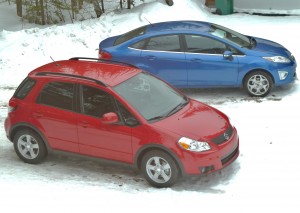
The Suzuki SX4, foreground, is an example of AWD fun in ice and snow, while the Ford Fiesta sedan proves front-wheel drive also has winter advantages.
By John Gilbert
When the auto industry changed over from the traditional front-engine/rear-drive to front-wheel drive, it not only provided flat floors and more spacious interiors, it instantly eliminated most of the treachery of winter driving, because of having the majority of weight over the wheels that not only drive the cars but do most of the braking and all of the steering, too.
Then along came all-wheel drive, which used to be available only on Audi and Subaru models, or otherwise required a truck or sport-utility vehicle to enjoy. But as we drive, slide and skid through this Upper Midwest winter-that-never-ended, it is worth noting how all-wheel drive has proliferated through the car industry. We’ve come a long way from the old truck-style 4-wheel drive that sent equal power to the front and rear axles, which meant that drivers could feel a tight binding up of the front wheels during a sharp turn, where the inside wheels don’t travel as far as the outside. Contemporary all-wheel drive adjusts power front and rear, as electronic components measure the tendency to spin, but also can alter the torque going from inside wheels to outside, in many cases.
When winter chose to send a last blast across the Upper Midwest to prove that March can still “go out like a lion,” it offered the chance to prove again how some cars perform well in winter, some don’t, and how some that would perform well on icy roads need better tires to do so. Consumers, and manufacturers, tend to forget that tires remain the only four contact points a vehicle has with the roadway, and suspension systems and tires that can make a car handle with great precision on dry roads might reduce rear-drive, front-drive and even all-wheel drive cars to white-knucklers in a storm.
Among the cars that stood out this soon-to-be-over winter, and even passed the “Duluth Hillside Blizzard” test, include the following:
Audi S5, A4 and A8, Cadillac SRX, Nissan Juke SV, Lincoln MKS, Subaru Impreza WRX, Volvo S60, Mitsubishi Evolution MR, Infiniti G37X, Ford Fusion, Taurus SHO, Suzuki SX4, Toyota Scion xD, Acura TL, and the Mercedes CL550 4Matic, and E350 4Matic wagon, and Porsche Panamera. Crossovers and SUVs that fit under the largest category were more predictably strong in foul weather, including the Ford Edge and Explorer, Chevrolet Equinox and Traverse, Dodge Durango and Nitro, Subaru Forester and Tribeca, Range Rover and Land Rover LR4, Volkswagen Touareg and Touareg Hybrid, GMC’s Terrain and Acadia, Porsche Cayenne, Hyundai Tucson, Kia’s Sorento EX and Sportage, Jeep’s Grand Cherokee and Patriot, and Mazda’s CX-7 and CX-9. Read more
Frattin, Sioux win Broadmoor Cup in 2OTs
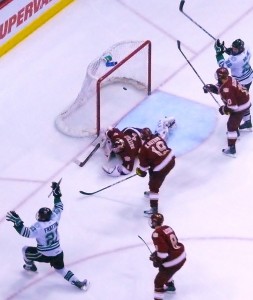
Matt Frattin (21) reacts after shooting past Denver goalie Sam Brittain for North Dakota's 3-2 double-overtime victory.
By John Gilbert
SAINT PAUL, MN. — For the second straight night, North Dakota had to turn to scoring champion and Hobey Baker finalist Matt Frattin for the game-winning goal, but this time he made 16,731 fans at Xcel Energy Center wait until the second overtime before scoring to boost the Fighting Sioux to a 3-2 victory over Denver in the WCHA Final Five championship game.
Frattin, who scored the winner with 5:40 remaining in North Dakota’s 4-3 semifinal victory over Colorado College, was the recipient of a collaboration with two of his fellow-seniors at 5:11 of the second sudden-death overtime session. Frattin’s quick work with a blocked shot brought him his 35th goal of the season and brought North Dakota the Broadmoor Cup. It also sends the Sioux flying into the NCAA tournament with a 29-8-3 record.
The three seniors who worked on the game-winning play are part of the “Magnificent Seven” Sioux seniors. Evan Trupp, summoning a burst of energy while players on both teams seemed to be running down from exhaustion, sped up the right side, and when he was checked away from the net, Trupp curled to the right corner and passed back to the right point. Chay Genoway cut loose from there with a big shot that was blocked, but the carom went wide to the left of the goal, where Frattin one-timed it before Denver goalie Sam Brittain could react.
“I don’t know where Trupp got the energy,” said Frattin. “He’s the Energizer Bunny. He gets his legs going and lifts the whole team. Then Chay got a good shot, and the rebound came right to me. Scoring this goal was right on top. The way they were playing, I didn’t think it was going to end anytime soon.”
It was Frattin’s seventh game-winning goal of the season, prompting coach Dave Hakstol to explain things in the post-game press conference. “We have a rule on this team,” deadpanned Hakstol, “that if you enter the offensive zone with the puck, and Frattin is on the ice, you have to give it to him.”
More seriously, Hakstol said: “We started with a quest to win the Broadmoor Cup, and we had to win four games to do it. Tonight, Denver had the better opportunities for 60 minutes, and the first few minutes of overtime, but we got a little rhythm in the second half of the first overtime, and it carried over to the second overtime. The bottom line is, we got a bounce, and it happened to land on the right guy’s stick.”
Denver, the season runner-up to the Sioux, is also assured of an NCAA berth with a 24-11-5 mark, and played a strong game to outshoot the Sioux 42-36 and force the overtime when Anthony Maiani came up with the equalizer with 2:13 left in the third period.
“We found ways to win our last four games,” said Denver coach George Gwozdecky. “We lost tonight, but to if we can play the league champion in a game like this, it’s a great thrill, a privelege, and an honor. The first eight or nine minutes of the first overtime, we played well, then we got a little loose defensively and gave gthem some chances, and Sam made some great saves to keep the puck out of the net.”
The Fighting Sioux spotted Denver a 1-0 lead in the first period, then scored twice in the first eight minutes of the second in the match of the WCHA’s top two physical heavyweights. Sometimes it seemed the physical play was more of a focal point than the game itself, particularly to the Fighting Sioux, who obviously wanted to knock the Pioneers off their game. Many college hockey games show an assortment of interference and tripping calls; not these guys. The 16 minor penalties in the three regulation periods had one interference and one for hooking, while the other 14 were six slashings, three roughings, three cross-checks, one boarding, and a face-masking.
The hitting and the ensuing chippiness detracted from the speed and flow that both teams are capable of, but it added an extra edge to the drama being played out over three periods, and on into overtime. Bodies continued to fly in the overtime, but the teams throttled back enough that the officials could put away their whistles and let the lads play. “They let the players decide the game,” said Hakstol.
Five minutes into the first period, Denver’s Kyle Ostrow and Maiani were forechecking deep, behind the Sioux goal, and Ostrow passed the puck out to the slot, where Dustin Jackson arrived just in time to hammer a quick shot before North Dakota goaltender Aaron Dell could react, giving the Pioneers an early 1-0 lead.
Fighting Sioux center Brad Malone and winger Brett Hextall were the most aggressive body-checkers, and when Malone threw a heavy hit after a whistle, igniting a small scuffle at the Sioux bench, he went off for boarding at 7:44, but North Dakota killed off the power play. Later in the period, the Sioux also found it difficult to generate anything at the other end on a power play, and the period ended 1-0 with Denver also holding a 10-6 edge in shots.
North Dakota responded with both its regulation goals early in the second period, both of which could have listed good luck in the assist bracket. At 2:32, Denver goaltender Sam Brittain blocked a shot that was just wide to the right, and when Danny Kristo tried to chip the rebound, he partially fanned on his shot and Pioneer center Nick Shore, closing in to defend, inadvertently kicked the puck and it wound up in the net for a 1-1 tie.
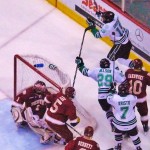
Brent Davidson, top, gave North Dakota a 2-1 lead with a bank shot from behind the net, off Denver goalie Sam Brittain.
A few minutes later, North Dakota killed Dillon Simpson’s cross-checking penalty, and Sioux left winger Brent Davidson broke across center ice, catching a pass, and breaking hard on the right side. A defender knocked the puck away from him, but Davidson got to it first on the end boards, then spun half way around and flipped it out front. The puck hit Brittain’s skate and the ricochet went in at 8:18 for a 2-1 Sioux lead.
Playing aggressively seemed to be in North Dakota’s favor, and even when they took penalties the Fighting Sioux kept attacking and got several good scoring chances short-handed. Corban Knight nearly made it 3-1 when he wound up with the puck and shot for the open right side of the net, but suddenly it wasn’t open, as Brittain dived across the crease and snared the shot with his glove.
The hitting took a couple tolls. Denver freshman scoring whiz Jason Zucker absorbed a knockdown from Hextall, and he didn’t return to his first-line post for most of the second period with an “upper body” injury. And as the period ended, Sioux defenseman and captain Genoway and a Denver player collided at the buzzer, and Genoway limped off the ice and was helped to the dressing room. Both returned to regular service in the third period, however.
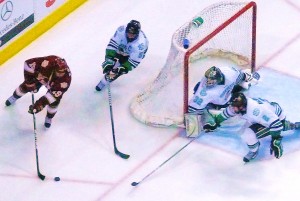
Denver's Kyle Ostrow outflanked Sioux defensemen Chay Genoway and Andrew MacWilliam (2), and goalie Aaron Dell, who made 40 saves.
The third period was another exercise in penalty killing, as neither team seemed willing to concentrate on just hockey, with so many physical challenges being offered. As the minutes passed, however, the Pioneers grew more intense, and fought through the checks for enough openings to establish an 11-4 edge in shots. At 17:47, after all the close checking, Denver caught the Sioux in a rare coverage lapse. The puck went out to the left point, and Matt Donovan passed ahead to a wide-open Beau Bennett, deep in the left corner. All alone, Bennett hesitated to let Maiani get clear of any checkers on the far side of the slot, then he sent him a perfect pass, and Maiani banged it in for the 2-2 deadlock.
Both sides had scoring chances in the first overtime, a 20-minute session, with Dell stopping 10 Denver shots, and Brittain 11, although North Dakota had the more dangerous threats. Brittain came up with a great glove save on Frattin, then stopped Taylor Dickinson’s break-in and also got Kristo’s follow-up. His best, though, was when Trupp was open for a point-blank one-timer, and Brittain kicked his left leg out and blocked the shot with his toe, just inside the right pipe.
Brittain came up with another similar toe save in the second overtime, and was ready for Genoway’s blast minutes later, but he had no chance on Frattin’s wide-angle winner.


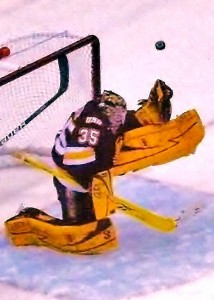
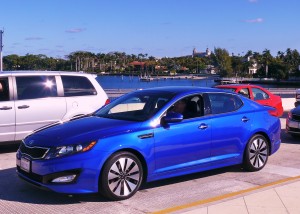
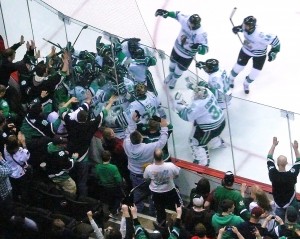
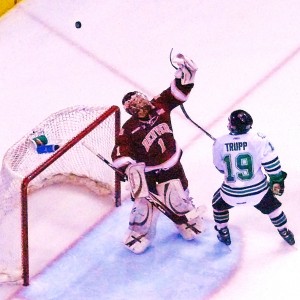
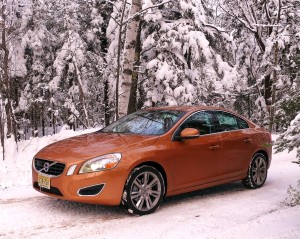
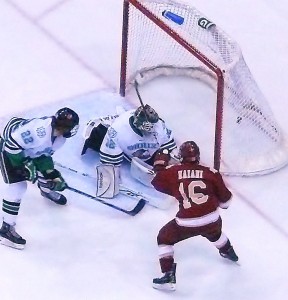
 John Gilbert is a lifetime Minnesotan and career journalist, specializing in cars and sports during and since spending 30 years at the Minneapolis Tribune, now the Star Tribune. More recently, he has continued translating the high-tech world of autos and sharing his passionate insights as a freelance writer/photographer/broadcaster. A member of the prestigious North American Car and Truck of the Year jury since 1993. John can be heard Monday-Friday from 9-11am on 610 KDAL(www.kdal610.com) on the "John Gilbert Show," and writes a column in the Duluth Reader.
John Gilbert is a lifetime Minnesotan and career journalist, specializing in cars and sports during and since spending 30 years at the Minneapolis Tribune, now the Star Tribune. More recently, he has continued translating the high-tech world of autos and sharing his passionate insights as a freelance writer/photographer/broadcaster. A member of the prestigious North American Car and Truck of the Year jury since 1993. John can be heard Monday-Friday from 9-11am on 610 KDAL(www.kdal610.com) on the "John Gilbert Show," and writes a column in the Duluth Reader.